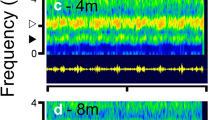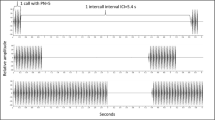Abstract
Males of the agaristid moth Hecatesia thyridiondefend small patches of coastal heathland in southwestern Australia in the late afternoon. As they fly back and forth low over their territories, they produce an acoustical signal. Neighboring males commonly fly toward each other; these interactions often result in aerial duels, with the eventual departure of one of the males. Playback experiments established that males were attracted to the sounds of other males. Females were observed to fly into territories and eventually mate with the signaling occupant. Marked males sometimes returned to the same spot on consecutive days. On any given day males occupied only a fraction of the sites that were acceptable territories. The mating system of H. thyridionappears to be a dispersed lek, with males acoustically advertising territories that are used for mating and not for feeding or oviposition.
Similar content being viewed by others
References
Alcock, J. (1975). Territorial behaviour by males ofPhilanthus multimaculatus (Hymenoptera: Sphecidae) with a review of territoriality in male sphecids.Anim. Behav. 23: 889–895.
Alcock, J. (1987). Leks and hilltopping in insects.J. Nat. Hist. 21: 319–328.
Alcock, J., and Gwynne, D. (1988). The mating system ofVanessa kershawi: Males defend landmark territories as mate encounter sites.J. Res. Lep. (in press).
Alcock, J., and Smith, A. P. (1987). Leks, hilltopping, and female choice in the carpenter bee,Xylocopa varipuncta.J. Zool. 211: 1–10.
Bailey, W. J. (1978). Resonant wing systems in the Australian whistling mothHecatesia (Agarasidae (sic), Lepidoptera).Nature 272: 444–446.
Blest, A. D., Collett, T., and Pye, J. D. (1963). The generation of ultrasonic signals by a New World arctiid moth.Proc. Roy. Soc. Lond. Ser. B 158: 196–207.
Bradbury, J. W. (1977). Lek mating behavior in the hammerheaded bat.Z. Tierpsychol. 45: 225–255.
Bradbury, J. W. (1985). Contrasts between insects and vertebrates in the evolution of male display, female choice, and lek mating. In Hölldobler, B. (ed.).Experimental Behavioral Ecology and Sociobiology, Sinauer Associates, Sunderland, Mass., pp. 273–289.
Burk, T. (1982). Evolutionary significance of predation on sexually-signalling males.Fla. Entomol. 65: 90–104.
Common, I. F. B. (1970). Lepidoptera. InThe Insects of Australia, CSIRO, Melbourne, pp. 765–866.
Common, I. F. B. (1974). Lepidoptera. InThe Insects of Australia, Supplement, CSIRO, Melbourne, pp. 98–107.
Dunning, D. C. (1968). Warning sounds of moths.Z. Tierpsychol. 25: 129–138.
Fullard, J. H. (1977). Phenology of sound-producing arctiid moths and the activity of insectivorous bats.Nature 267: 42–43.
Fullard, J. H., and Fenton, M. B. (1977). Acoustic and behavioural analyses of the sounds produced by some species of Nearctic Arctiidae (Lepidoptera).Can. J. Zool. 55: 1213–1224.
Greenfield, M. D. (1981). Moth sex pheromones: An evolutionary perspective.Fla. Entomol. 64: 4–17.
Gwynne, D. T. (1978). Male territoriality in the bumblebee wolfPhilanthus bicinctus (Mickel) Hymenoptera: Sphecidae): Observations of the behaviour of individual males.Z. Tierpsychol. 47: 89–103.
Gwynne, D. T., and Edwards, E. D. (1986). Ultrasound production by genital stridulation inSyntonarcha iriastis (Lepidoptera: Pyralidae): Long-distance signalling by male moths?Zool. J. Linn. Soc. 88: 363–376.
Marshall, L. D., and Alcock, J. (1981). The evolution of the mating system of the carpenter beeXylocopa varipuncta (Hymenoptera: Anthophoridae).J. Zool. 193: 315–324.
McFarland, N. (1976). Hilltopping and defence behaviour in a diurnal agaristid moth.Aust. Entomol. Mag. 3: 25–29.
Nicholson, A. R. (1955). Comments.Proc. Roy. Entomol. Soc. Lond. 20: 13.
Schmidt, J. O., O'Neill, K., Fales, H. M., McDaniel, C. A., and Howard, R. W. (1985). Volatiles from mandibular glands of male beewolves (Hymenoptera: Sphecidae,Philanthus) and their possible roles.J. Chem. Ecol. 11: 895–901.
Spangler, H. G., Greenfield, M. D., and Takessian, K. (1984). Ultrasonic mate calling in the lesser wax moth.Physiol. Entomol. 9: 87–95.
Surlykke, A., and Miller, L. A. (1985). The influence of arctiid moth clicks on bat echolocation: Jamming or warning?J. Comp. Physiol. A 156: 831–843.
Thornhill, R., and Alcock, J. (1983).The Evolution of Insect Mating Systems, Harvard University Press, Cambridge, Mass.
Author information
Authors and Affiliations
Rights and permissions
About this article
Cite this article
Alcock, J., Gwynne, D.T. & Dadour, I.R. Acoustic signaling, territoriality, and mating in whistling moths,Hecatesia thyridion (Agaristidae). J Insect Behav 2, 27–37 (1989). https://doi.org/10.1007/BF01053616
Accepted:
Issue Date:
DOI: https://doi.org/10.1007/BF01053616




